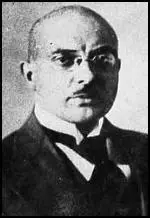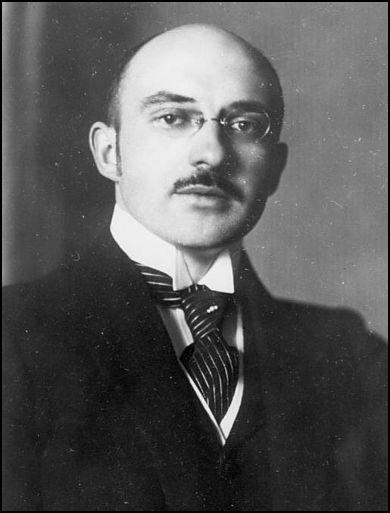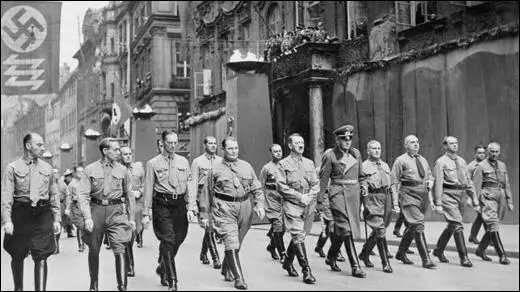Max Scheubner-Richter

Max Scheubner-Richter was born in Riga on 21st January 1884. He fought for Tsar Nicholas II during the 1905 Russian Revolution. During this period he married the daughter of a factory owner.
During the First World War he was the German vice consul of Erzerum. According to A he was involved in "stirring up trouble among the Armenians and amongst the Kurdish tribes." After the Russian Revolution he fled to Germany. He became the leader of the Aufbau Vereinigung, a group of White Russian reactionary émigrés. Another member was Alfred Rosenberg and together they joined the Nazi Party (NSDAP).
William L. Shirer, the author of The Rise and Fall of the Third Reich (1964) has claimed: "Max Scheubner-Richter was a dubious character who like Rosenberg, had spent most of his life in the Russian Baltic provinces and after the war made his way with other refugees from the Soviet Union to Munich, where he joined the Nazi Party and became one of Hitler's close confidants."
With the help of Ernst Roehm, in February 1923, Adolf Hitler entered into negotiations with the Patriotic Leagues in Bavaria. This included the Lower Bavarian Fighting League, Reich Banner, Patriotic League of Munich and Oberland Defence League. A joint committee was set up under the chairmanship of Hermann Kriebel, the military leader of the Working Union of the Patriots Fighting Associations. Over the next few months Hitler and Roehm worked hard to bring in as many of the other right-wing groups as they could.
Gustav Stresemann, of the German National People's Party (DNVP), with the support of the Social Democratic Party, became chancellor of Germany in August 1923. On 26th September, he announced the decision of the government to call off the campaign of passive resistance in the Ruhr unconditionally, and two days later the ban on reparation deliveries to France and Belgium was lifted. He also tackled the problem of inflation by establishing the Rentenbank. Alan Bullock, the author of Hitler: A Study in Tyranny (1962) has pointed out: "This was a courageous and wise decision, intended as the preliminary to negotiations for a peaceful settlement. But it was also the signal the Nationalists had been waiting for to stir up a renewed agitation against the Government."
Hermann Kriebel, Adolf Hitler, Hermann Goering and Ernst Roehm had a meeting together on 25th September where they discussed what they were to do. Hitler told the men that it was time to take action. Roehm agreed and resigned his commission to give his full support to the cause. Hitler's first step was to put his own 15,000 Sturm Abteilung men in a state of readiness. The following day, the Bavarian Cabinet proclaimed a state of emergency and appointed Gustav von Kahr, one of the best-known politicians, with strong right-wing leanings, as State Commissioner with dictatorial powers. Kahr's first act was to ban Hitler from holding meetings.
General Hans von Seeckt made it clear that he would take action if Hitler attempted to take power. As William L. Shirer, the author of The Rise and Fall of the Third Reich (1964), has pointed out: "He issued a plain warning to... Hitler and the armed leagues that any rebellion on their part would be opposed by force. But for the Nazi leader it was too late to draw back. His rabid followers were demanding action." Wilhelm Brückner urged him to strike at once: "The day is coming, when I won't be able to hold the men back. If nothing happens now, they'll run away from us."

A plan of action was suggested by Max Scheubner-Richter and Alfred Rosenberg. The two men proposed to Hitler that they should strike on 4th November during a military parade in the heart of Munich. The idea was that a few hundred storm troopers should converge on the street before the parading troops arrived and seal it off with machine-guns. However, when the SA arrived they discovered the street was fully protected by a large body of well-armed police and the plan had to be abandoned. It was then decided that the putsch should take place three days later.
On 8th November, 1923, the Bavarian government held a meeting of about 3,000 officials. While Gustav von Kahr, the prime minister of Bavaria was making a speech, Adolf Hitler and 600 armed SA men entered the building. According to Ernst Hanfstaengel: "Hitler began to plough his way towards the platform and the rest of us surged forward behind him. Tables overturned with their jugs of beer. On the way we passed a major named Mucksel, one of the heads of the intelligence section at Army headquarters, who started to draw his pistol as soon as he saw Hitler approach, but the bodyguard had covered him with theirs and there was no shooting. Hitler clambered on a chair and fired a round at the ceiling." Hitler then told the audience: "The national revolution has broken out! The hall is filled with 600 armed men. No one is allowed to leave. The Bavarian government and the government at Berlin are hereby deposed. A new government will be formed at once. The barracks of the Reichswehr and the police barracks are occupied. Both have rallied to the swastika!"
Leaving Hermann Goering and the SA to guard the 3,000 officials, Hitler took Gustav von Kahr, Otto von Lossow, the commander of the Bavarian Army and Hans von Seisser, the commandant of the Bavarian State Police into an adjoining room. Hitler told the men that he was to be the new leader of Germany and offered them posts in his new government. Aware that this would be an act of high treason, the three men were initially reluctant to agree to this offer. Adolf Hitler was furious and threatened to shoot them and then commit suicide: "I have three bullets for you, gentlemen, and one for me!" After this the three men agreed.
Hitler dispatched Max Scheubner-Richter to Ludwigshöhe to collect General Eric Ludendorff. He had been leader of the German Army at the end of the First World War. Ludendorff had therefore found Hitler's claim that the war had not been lost by the army but by Jews, Socialists, Communists and the German government, attractive, and was a strong supporter of the Nazi Party. However, according to Alan Bullock, the author of Hitler: A Study in Tyranny (1962): "He (Ludendorff) was thoroughly angry with Hitler for springing a surprise on him, and furious at the distribution of offices which made Hitler, not Ludendorff, the dictator of Germany, and left him with the command of an army which did not exist. But he kept himself under control: this was a national event, he said, and he could only advise the others to collaborate."
While Adolf Hitler had been appointing government ministers, Ernst Roehm, leading a group of storm troopers, had seized the War Ministry and Rudolf Hess was arranging the arrest of Jews and left-wing political leaders in Bavaria. Hitler now planned to march on Berlin and remove the national government. Surprisingly, Hitler had not arranged for the Sturm Abteilung (SA) to take control of the radio stations and the telegraph offices. This meant that the national government in Berlin soon heard about Hitler's putsch and gave orders to General Hans von Seeckt for it to be crushed.
Gustav von Kahr, Otto von Lossow and Hans von Seisser, managed to escape and Von Kahr issued a proclamation: "The deception and perfidy of ambitious comrades have converted a demonstration in the interests of national reawakening into a scene of disgusting violence. The declarations extorted from myself, General von Lossow and Colonel Seisser at the point of the revolver are null and void. The National Socialist German Workers' Party, as well as the fighting leagues Oberland and Reichskriegsflagge, are dissolved."

Wilhelm Brückner, Julius Streicher and Wilhelm Frick on the march to the War Ministry
The next day Max Scheubner-Richter, Wilhelm Brückner, Hermann Kriebel, Adolf Hitler, Eric Ludendorff, Julius Steicher, Hermann Goering and 3,000 armed supporters of the Nazi Party marched through Munich in an attempt to join up with Roehm's forces at the War Ministry. At Odensplatz they found the road blocked by the Munich police. What happened next is in dispute. One observer said that Hitler fired the first shot with his revolver. Another witness said it was Steicher while others claimed the police fired into the ground in front of the marchers.
William L. Shirer has argued: "At any rate a shot was fired and in the next instant a volley of shots rang out from both sides, spelling in that instant the doom of Hitler's hopes. Scheubner-Richter fell, mortally wounded. Goering went down with a serious wound in his thigh. Within sixty seconds the firing stopped, but the street was already littered with fallen bodies - sixteen Nazis and three police dead or dying, many more wounded and the rest, including Hitler, clutching the pavement to save their lives."
Louis L. Snyder later commented: "In seconds 16 Nazis and 3 policeman lay dead on the pavement, and others were wounded. Goering, who was shot through the thigh, fell to the ground. Hitler, reacting spontaneously because of his training as a dispatch bearer during World War I, automatically hit the pavement when he heard the crack of guns. Surrounded by comrades, he escaped in a car standing close by. Ludendorff, staring straight ahead, moved through the ranks of the police, who in a gesture of respect for the old war hero, turned their guns aside."
Apparently Adolf Hitler was very upset by the death of and dedicated Mein Kampf to his memory.
Primary Sources
(1) William L. Shirer, The Rise and Fall of the Third Reich (1964)
At any rate a shot was fired and in the next instant a volley of shots rang out from both sides, spelling in that instant the doom of Hitler's hopes. Scheubner-Richter fell, mortally wounded. Goering went down with a serious wound in his thigh. Within sixty seconds the firing stopped, but the street was already littered with fallen bodies - sixteen Nazis and three police dead or dying, many more wounded and the rest, including Hitler, clutching the pavement to save their lives.
There was one exception, and had his example been followed, the day might have had a different ending. Ludendorff did not fling himself to the ground. Standing erect and proud in the best soldierly tradition, with his adjutant, Major Streck, at his side, he marched calmly on between the muzzles of the police rifles until he reached the Odeonsplatz. He must have seemed a lonely and bizarre figure. Not one Nazi followed him. Not even the supreme leader, Adolf Hitler.
The future Chancellor of the Third Reich was the first to scamper to safety. He had locked his left arm with the right arm of Scheubner-Richter (a curious but perhaps revealing gesture) as the column approached the police cordon, and when the latter fell he pulled Hitler down to the pavement with him. Perhaps Hitler thought he had been wounded; he suffered sharp pains which, it was found later, came from a dislocated shoulder. But the fact remains that according to the testimony of one of his own Nazi followers in the column, the physician Dr Walther Schulz which was supported by several other witnesses, Hitler "was the first to get up and turn back", leaving his dead and wounded comrades lying in the street. He was hustled into a waiting motor car and spirited off to the country home of the Hanfstaengls at Uffing, where Putzi's wife and sister nursed him and where, two days later, he was arrested.
Ludendorff was arrested on the spot. He was contemptuous of the rebels who had not had the courage to march on with him, and so bitter against the Army for not coming over to his side that he declared henceforth he would not recognize a German officer nor ever again wear an officer's uniform. The wounded Goering was given first aid by the Jewish proprietor of a nearby bank into which he had been carried and then smuggled across the frontier into Austria by his wife and taken to a hospital in Innsbruck. Hess also fled to Austria. Roehm surrendered at the War Ministry two hours after the collapse before the Feldherrnhalle. Within a few days all the rebel leaders except Goering and Hess were rounded up and jailed.
Student Activities
Adolf Hitler's Early Life (Answer Commentary)
The Hitler Youth (Answer Commentary)
German League of Girls (Answer Commentary)
The Political Development of Sophie Scholl (Answer Commentary)
The White Rose Anti-Nazi Group (Answer Commentary)
Kristallnacht (Answer Commentary)
Heinrich Himmler and the SS (Answer Commentary)
Trade Unions in Nazi Germany (Answer Commentary)
Adolf Hitler v John Heartfield (Answer Commentary)
Hitler's Volkswagen (The People's Car) (Answer Commentary)
Women in Nazi Germany (Answer Commentary)
The Assassination of Reinhard Heydrich (Answer Commentary)
The Last Days of Adolf Hitler (Answer Commentary)
